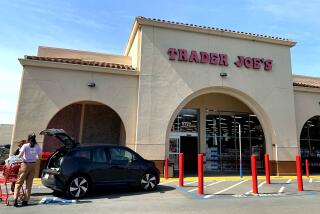State finds lead hazard in its free lunch totes
The hundreds of thousands of lunchboxes given away by state health officials were designed to promote healthful habits, bearing slogans such as “Eat Fruits & Vegetables and Be Active.” Just one problem: At least some of them were made with unhealthful levels of lead.
The California Department of Public Health said Thursday that it was recalling 300,000 green and blue canvas lunch coolers made in China and distributed throughout the state at health fairs and other events since 2004.
“It’s unfortunate that an item we’re using hopefully to promote healthy behavior is discovered itself to be a potential health hazard,” said Dr. Mark Horton, director of the state’s public health department and a pediatrician. “Kids have a habit of putting their hands in their mouth a lot, and the food inside the lunchbox possibly could be contaminated.”
The recall underscores the difficulty of ensuring the safety of millions of products produced around the world and sold -- or given away -- in the United States. A wave of high-profile toy recalls this year, including millions of Mattel Inc. products containing lead paint, spurred manufacturers and retailers to implement new controls. The problem with lead in consumer products, however, goes beyond one industry, activists say.
No injuries have been reported as a result of the lead-tainted lunchboxes, California health officials said. But no exposure to lead is considered safe.
Lead is particularly dangerous to the developing brains and nervous systems of children. Exposure, usually as a result of deteriorating old paint in a home, can affect a child’s learning ability, hearing, height, nervous system and gastrointestinal tract and, in larger doses, can cause seizures, coma and death.
Children deficient in iron and other key nutrients are particularly susceptible to lead poisoning. Many of the now-recalled lunchboxes went to low-income Californians, including recipients of food stamps.
The recall includes 56,000 dark-green canvas lunchboxes with Spanish and English versions of the “Eat Fruits & Vegetables” logo. State health officials were alerted to the problem after technicians from the Sacramento County Health Department, doing a spot check in late July, found elevated lead levels.
Subsequent tests by the state’s Department of Toxic Substances Control found that multiple parts of the boxes, such as the vinyl lining, contained lead.
The highest lead levels were found in the bag’s decorative logo, a shining yellow sun and brightly colored fruits and vegetables along with the www.ca5aday.com Web address.
Horton said the tests showed lead levels “significantly above” 600 parts per million, the legal limit. One box tested at 1,700 parts per million, according to the Department of Public Health.
Although lead paint has been banned in the United States since 1978, factories in some countries have used lead as an inexpensive way to, among other things, make paint dry faster and last longer.
The department said it also was recalling about 245,000 blue canvas lunchboxes distributed as part of two other state programs, the Network for a Healthy California and the Special Supplemental Program for Women, Infants and Children, or WIC.
The blue lunchboxes, with similar logos urging consumers to “Eat 5 a Day,” have not tested positive for lead, the department said, but are being recalled as a precaution.
The health department said consumers should stop using the boxes and return them to the place they got them or take them to a local household hazardous waste collection facility for disposal.
Importer T-A Creations Inc. of Los Angeles said the products passed lead and other quality tests before being exported from the Chinese manufacturer, Quan Zhou Wei Wah Industries in Fujian province.
Still, T-A Chief Executive David Chen said his company always recommends that buyers include a label warning that the products might contain lead, a known hazard.
“A lot of materials contain lead; we just don’t know how [much], so even though we pass all the tests, we give the suggestion to put a warning label in there,” Chen said. “My customers say, ‘No, we don’t really need it.’ ”
Soft, cooler-type lunchboxes have been a target of environmental and health activists for years because some manufacturers have used lead during production to stabilize the boxes’ vinyl lining.
The Center for Environmental Health in Oakland said the problem had lessened since it sued lunchbox manufacturers in 2005, alleging that they violated California’s Proposition 65, which in 1986 began requiring warning labels on all products known to cause cancer, birth defects or reproductive harm.
In 2005, 10% to 20% of the 200 lunchboxes the group tested had high lead levels, said research director Caroline Cox. Last month, when the group repeated its survey, few if any contained lead, she said.
A spokeswoman for the state health department said the state received some of the now- recalled bags from a contractor, KP Fulfillment. KP bought just over 100,000 of the cooler bags last November and still has more than 43,700 of them. The remaining 56,396 coolers “are in the hands of our partners or consumers,” said spokeswoman Suanne Buggy.
Although lead is a common component of many regular household items, it cannot be in any consumer product sold in California unless the product bears a Proposition 65 warning.
Every year, toys and other children’s products are recalled by the Consumer Product Safety Commission because lead is discovered in the products’ paint.
But this year’s wave of recalls of Chinese-made products, including lead-paint problems with millions of toys from well-known brands such as Mattel, has riled consumers and lawmakers.
The problem with the lunchboxes is regrettable but not surprising, said Dr. Ralph Salimpour, a lead expert and pediatrician at UCLA. “It should open our eyes,” he said.
Dr. Gina Solomon, a public health specialist with the Natural Resources Defense Council in San Francisco, said that overall, the recent crush of recalls has resulted in heightened awareness, which is positive.
“I would give the Department of Public Health a lot of credit for admitting the problem and taking action,” she said.
--
marc.lifsher@latimes.com
--
(BEGIN TEXT OF INFOBOX)
The specifics
What is being recalled?
About 245,000 blue canvas lunchboxes labeled “Eat 5 a Day” and 56,000 dark-green canvas lunchboxes with Spanish and English versions of the “Eat Fruits & Vegetables” logo. The totes were given away by state health officials.
Why are the boxes being recalled?
Some of the items may contain unhealthful levels of lead.
What should consumers do?
Stop using the boxes and return them to the place they got them or take them to a local household hazardous waste collection facility for disposal.
Why is lead hazardous?
Lead is particularly dangerous to the developing brains and nervous systems of children. Exposure can affect a child’s learning ability, hearing, height and gastrointestinal tract and, in larger doses, can cause seizures, coma and death.
Why is it used in consumer products?
Although lead paint has been banned in the United States since 1978, factories in some countries have used lead as an inexpensive way to, among other things, make paint dry faster and last longer. Lead can also be used as a stabilizer in other products.
Source: Times reporting
More to Read
Start your day right
Sign up for Essential California for news, features and recommendations from the L.A. Times and beyond in your inbox six days a week.
You may occasionally receive promotional content from the Los Angeles Times.







